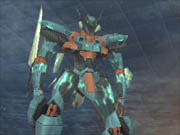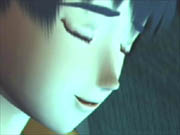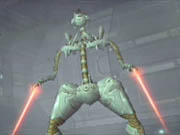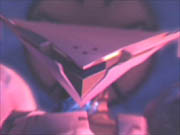There aren't many game designers mentioned in the same breath as Shigeru Miyamoto and Yu Suzuki. But Hideo Kojima is one of them. The mind behind Metal Gear Solid has established a reputation for dramatic cinematics, innovative game design, and attention to detail. Kojima has been working on Konami's new mech-o-drama, Zone of the Enders, in tandem with the new Metal Gear, and it's blatantly obvious which project Kojima has spent the majority of his time working on. The product of neglect, ZOE, fails to live up to the lofty Kojima standards but delivers a technically sound and smooth-playing experience.

ZOE takes place in 2172. Humans have left Earth to reside in space colonies throughout the galaxy. Leo Stenbuck, ZOE's young protagonist, resides in Antilia, a space station orbiting Jupiter. Denizens of such far-flung colonies are tagged as enders and considered the lowest of all the social classes. Normally a sleepy community where its citizens go methodically about their everyday lives, Antilia springs to life when a marauding group of orbital frames invades the colony in search of a hidden mech. Caught in the middle, Leo gets blown into a hangar by a large explosion, but not before watching his friends become slaughtered by the blast. Leo takes refuge in the hangar until he is discovered and accidentally stumbles into the cockpit of Jehuty, the very orbital frame that the enemy mechs are searching for. Leo, after some prodding from the mech's owners, takes on the responsibility of ridding his colony of the stalwart frames.
Piloting the orbital frames in ZOE is a blast, thanks to a near-perfect lock-on function and responsive movement control. You may engage the enemy without worrying about navigating terrain, as well as zip in and out of buildings while dodging enemy attacks at the same time. Jehuty's offensive arsenal differs according to its distance from a locked-on enemy--at a distance, Jehuty's primary attack acts as a projectile, but up close, it lets the frame use its electrified sword to slash the enemies into scrap heaps. Likewise, using the secondary attack from long-range lets Jehuty use its special weapons, and while up close, it will grab the enemy and send it careening into the side of a building--or better yet, into another group of frames. The combat system is smooth and intuitive but unbalanced. The entire game may be beaten on all four difficulty settings using just one attack. You can mix it up if you wish, but there's no fun in knowing that when the chips are down, you can always bail yourself out.

The game design is very simple. Jehuty flies above Antilia in what is best described as an overworld. When Jehuty soars directly over a town, a single button press lets the frame swoop down to the surface. Once on the ground, Jehuty must search for programs, as well as discs that give the frame new abilities. Acquiring the discs is accomplished by destroying certain enemies, finding hidden areas, or shooting floating canisters using a frustratingly erratic aiming system. Many times, you will have to return to previously visited areas to retrieve items and then take them somewhere else for use. The infantile scavenger hunts seem out of place when coupled with the fast-paced nature of the game, and the constantly respawning enemies don't help matters, either. Jehuty must occasionally answer your SOS calls--when it does, you're graded upon how many buildings were destroyed and how many innocent civilians perished. The ratings you earn ultimately determine the ending you receive. After the one-player quest is completed, a multiplayer mode, which lets two players compete head-to-head, is unlocked. It's a nice way to perfect your combat skills, and it accentuates ZOE's finest trait.

ZOE has the kind of graphics that will make your friends stop wondering why you camped out in the rain for a PlayStation 2. For the first two hours, it's the most visually impressive PlayStation 2 game to date. Everything moves at lightning pace while buildings are crumbling, lasers are being sent in multiple directions, and heat blur and other nifty effects are all firing at once. It can approach sensory overload at times, yet the frame rates never falter. The anime-influenced orbital frames are incredibly detailed and have a unique style. Dynamic high-resolution textures simulate energy running through veinlike ducts, and gorgeous particle effects are used to illustrate the thrusters. Each of the massive bosses changes form after taking damage, and they are, by far, the graphical highlight of the game. Both the beginning and end of the game are loaded with FMV sequences that help move the plot forward, while the middle of the game is bolstered by real-time cinemas. Like the gameplay, the graphics become a victim of repetition--while there are plenty of areas to explore, they all look roughly the same. This holds true of the enemies as well. Sans bosses, there are just three different enemies that you must fight over and over.
From an auditory standpoint, ZOE has its good and bad points. The raucous techno changes on the fly according to the action taking place onscreen, and the explosions come from all directions if you're playing with a surround-sound system. As is the case with many games developed first for the Japanese market, the script is wordy and far too sappy for the older audience that ZOE is attempting to attract. The dry, emotionless voice acting only makes it worse.

For the first couple of hours, ZOE is a class-A game. But amazement then gives way to apathy, due to the lethargic gameplay. Redundant enemies, objectives, and landscapes eventually wear on you to the point that the measly five to seven hours it takes to complete the game seems too long. The combat system is the focus, and the remainder of the game is left to twist in its own monotony. While it has its moments, Zone of the Enders will ultimately be remembered more for its packed-in demo of Metal Gear Solid 2 than its own accomplishments as a video game.